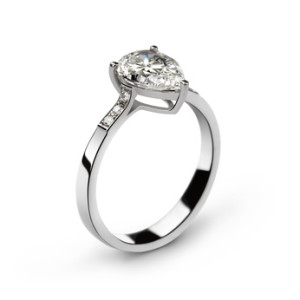White gold and yellow gold are both very popular choices for rings. But what should you do when you are undecided about which of the two you should pick? Let’s see how white and yellow gold rings differ and what you should consider when deciding between these two materials.
How White Gold and Yellow Gold Are Made
White gold is actually made of yellow gold mixed with metals such as manganese and palladium to make the alloy white.

White gold ring with diamonds
Jewelry made of white gold is usually coated with a layer of rhodium so as to make the piece look even whiter.
Yellow gold is also mixed with other metals, but the main reason for doing so is to make the alloy harder and more durable, not to change its color.
Durability: White Gold vs. Yellow Gold
Rings made of white gold are usually more durable than yellow gold ones.
The reason is not so much that white gold may contain less pure gold (which is soft), but that it is plated with rhodium, which is a pretty durable metal.
As a result, white gold rings are harder to bend and scratch than those made of yellow gold.
This is not to say that you cannot find a durable yellow gold ring, but to come close to the durability white gold offers, you would have to go with a yellow gold piece that has a low karat number.
For example, 10-karat yellow gold contains close to 60% other metals, which make the alloy harder and not easy to scratch. 18-karat yellow gold rings, on the other hand, are softer compared with white gold rings with a similar karat number.
Maintenance
Since yellow gold rings are usually softer, they scratch more easily and require more frequent polishing than white gold items. In addition, a yellow gold ring needs to be checked for damage and repaired more often as its parts are more likely to bend or break.
While white gold is more durable and easier to maintain, it still requires some care. The rhodium plating of white gold rings wears off with time depending on how often you wear your jewelry.
When the rhodium layer starts to disappear, you will need to have the piece replated (usually done at jewelry shops for a fee).
And keep in mind that while white gold is harder to scratch and needs to be polished less frequently, the polishing process wears away the rhodium plating, little by little.
Nickel Content
Both white and yellow gold rings may contain nickel. If you are allergic to this metal, make sure to ask if the jewelry you are considering has nickel content.
One thing to keep in mind is that even if a white gold ring contains nickel, its rhodium plating will keep it from coming into contact with your skin.
However, when the rhodium wears off, you might get a rash if you are allergic and the nickel concentration is high enough. To be on the safe side, look for rings that are at least 14 or 18 karats, or buy jewelry that is nickel free.
How Important Is Color?
It is up to you whether you would prefer the color of yellow or white gold.
However, if your ring will have diamonds, keep in mind that if their color is low grade, any yellowish tints in the stones will be amplified as they will stand out in a white gold setting.
For such diamonds, a yellow gold mounting will be better as they will look whiter against it.
Which Is Cheaper?
The price of gold depends on its karat, but usually, a white gold ring will be more expensive than a yellow gold one, even when they have the same karats.
This is mainly due to the rhodium plating white gold jewelry has: Rhodium is expensive, and rings with thicker plating will be pricier (but also more durable).
Deciding Between White and Yellow Gold
In sum, pick a white gold ring if you like the color and are ready to pay more for better durability. Also, if you will have a colorless or nearly colorless diamond set in your ring, white gold is the way to go.
Yellow gold is a better choice if you prefer a warmer color and are willing to sacrifice some durability for a lower price. A ring made of yellow gold is also a better choice if your diamond has some yellowish tints.
